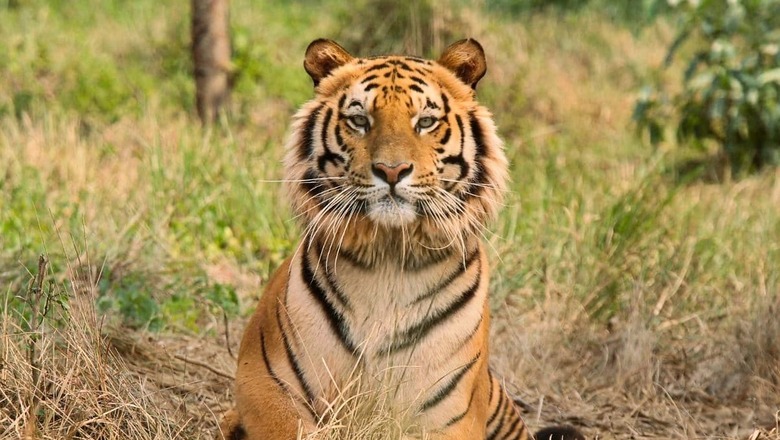
views
It’s a great feeling to know that the number of tigers in the wild in India has gone up from 1,827 (based on the rather imprecise methods) in 1973 when Project Tiger was launched to the more scientifically ascertained 1,411 in 2006 to 3,167 today. But few appreciate the enormity of this achievement, given that India’s humans — in the wild and otherwise — have more than doubled since 1973, in crores, not thousands: 59.61 crore in 1973 to 141 crore in 2023!
But India also has 431 people per square kilometre. No other country with tigers — or other endangered species — has such a population pressure. The Amoy tiger, native to southern China, is now extinct in the wild. And there are only an estimated 500 Amur or Siberian tigers left; they once roamed the vast borderlands between the Russian Far East, northern China and Korea. And the population densities of China and Russia are 153 and 9 people per sq km.
It must be noted that three tiger subspecies are already extinct — the last Balinese tiger was killed in 1937 and the Caspian tiger was eliminated in the 1950s. The last sighting of the once-abundant Javan tiger was in the mid-1970s. As was the case in so many tiger habitats, the arrival of white colonials spelt doom for Javan tigers: the Dutch occupiers put huge bounties on them to overcome traditional local reluctance to kill them if they had not harmed anyone.
Most countries in Asia that still have tigers also have human population densities far less than India. Indonesia is 151 per sq km and Thailand is 137 per sq km for example. Only Bangladesh at 1,265 people per sq km far exceeds India’s. Their latest tiger census began in February 2023 and is expected to be completed next year but their tiger number five years ago was 114 (mainly in the Sunderbans), up from 106 in 2015 but alarmingly down from 404 in 2004.
That India came back from the brink is an ode to not only the authorities that have ensured there are now 53 wildernesses designated as tiger sanctuaries (up from the initial 9 in 1973) but also the majority of ordinary Indians who have had the foresight to live and let live even as land has become scarce. Poachers are aberrations, not the norm here. More and more people in India have realised that the real value of tigers lies beyond their skin, claws and teeth.
The enormous distance India has travelled in terms of attitudes has never been adequately appreciated. We were left with a colonial legacy that saw wild animals as “game” — to be killed at will for clearing land for farming or simply for blood sport. Our maharajas also imbibed that attitude, and the walls of their palaces bear evidence of their enthusiasm. Even post-Independence the penny did not drop: India advertised hunting — shikar — as a tourist attraction.
A lot hinged on the word ‘game’. Ranthambore National Park was set up in 1955 as the Sawai Madhopur Game Sanctuary, most probably to attract shikar tourists. Game denotes wild mammals, reptiles and birds hunted for products (mostly meat and fur) and for sport (‘trophies’ such as heads, skins, horns, ivory, etc). It is not a coincidence that game is also a word synonymous with sport — for recreation — and hunting was just that for elites, particularly in the West.
The era of colonisation afforded Western elites a new set of “game” — lions, tigers, elephants, rhinos — to hunt for fun, with better and better weapons, not to mention retinues of ‘beaters’ to drive them out of the foliage to be shot. Unfortunately, the magnificence and elusiveness of tigers made them the most highly sought after. With maharajas also eagerly joining colonial rulers in their obsessive pursuit of this ‘sport’, tiger numbers obviously dropped dramatically.
Coincidentally if not intentionally, India’s Wildlife Protection Act — which banned all forms of hunting (but not angling) — happened in 1972, the same year that privy purses for India’s royal families were abolished. WPA meant our wild animals were no longer “game”. It meant farmers could not kill those that endangered their crops and livestock, but it put a lid on hunting “game” for sport. The latest tiger census is proof that India decided correctly.
Contrast that with the convulsions that many other nations have gone through (and in some cases, are still squabbling) about hunting wild animals. For many countries, wild animals are resources to be managed (and culled/killed if need be) not creatures with a right to live in the land of their forebears as much as ours. Some African nations also fell for that mantra and use their animals as bait, quite literally, to attract white hunters as “big game” is big money.
In South Africa it is legal to hunt lions — for a fat fee, of course. Those who run wildlife resorts often also have a side business of keeping animals—including antelopes, impalas, warthogs, Cape buffalo and lions—on private lands elsewhere for hunting tourists, mostly from Western nations. And this is accepted as a “pragmatic” way to “preserve” these species. China’s gruesome tiger farms are rightly criticised but not these; the reason for duplicity is clear.
Abundance is often given as an excuse to hunt. That is why within decades the number of tigers in India plummeted from around 40,000 to just 1,411. Yes, Indians did hunt before colonial rule, but never to extinction. Take the cheetah, which was never hunted but traditionally captured by royals to be kept as pets as they did not attack humans. But under the British, a bounty was put on cheetahs to clear jungles for farming. Their numbers never recovered.
Today, wild black bears, which are still found aplenty across the US — around 400,000 — can be legally hunted in 33 states. There are only 50,000 grizzly bears left in the US, but it is legal to hunt them too, even in places that previously banned it as their numbers had been dangerously depleted. Now words like “harvested” and “culled” are used to gloss over the fact that around 50,000 wild bears are legally shot and killed by permit every year in the US.
The usual ostensible reason is that wild bear numbers have risen too high and they need to be kept away from human habitats. But the population density of the US is a mere 36 people per sq km, so why should bears be a problem? Canada has a population of 60,000 wild wolves which are legally considered to be “game”. So they are shot for sport, not for human-wolf conflict presumably as Canada’s population density is 4 — yes, four —people per sq km.
Luckily India did not swallow that line, in the name of foreign exchange or bloodthirsty “sport” hunters. Unlike Pakistan, that allows Middle Eastern visitors to come and hunt houbara bustards, besides Blue Sheep, the Sindh and Himalayan Ibex, the Blandford, Afghan and Punjab Urial, and the Astor, Kashmir and Suleiman Markhor. They are all hunted ‘in season’ — November to April. This year it has been suspended due to the weather. Small mercies.
India has, instead, focused on saving — truly, not “pragmatically” — tigers and other wild animals. This policy has not changed though different political dispensations have held power, because Indians have been supportive of it. Thus the credit for conservation — particularly the success of Project Tiger — goes not only to proactive governments and Prime Ministers but also (given the pressure on land) to 141 crore Indians. We have set an example for the world.
The author is a freelance writer. Views expressed are personal.
Read all the Latest Opinions here



















Comments
0 comment